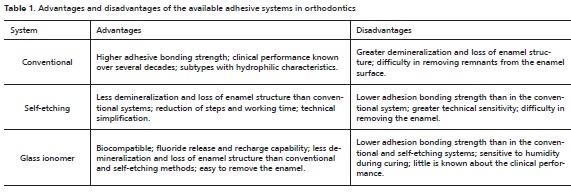Serviços Personalizados
Artigo
Links relacionados
Compartilhar
Revista Brasileira de Odontologia
versão On-line ISSN 1984-3747versão impressa ISSN 0034-7272
Rev. Bras. Odontol. vol.74 no.1 Rio de Janeiro Jan./Mar. 2017
Letters to the Editor/Orthodontics
Adhesive systems in orthodontics
Dikson ClaudinoI
I Postgraduate Program in Health Science, Universidade do Sul de Santa Catarina, Tubarão, SC, Brasil
Dear editor,
The article by Arinelli and colleagues1 published in the latest edition of your journal provides relevant information about adhesive systems currently used in dentistry. The focus of their study is on the clinical practice of restorative dentistry. However, it is worth mentioning that the development and application of adhesive systems extrapolate the standardized treatment protocols of this specialty, encompassing different management procedures and related clinical difficulties.
In orthodontics, adhesive systems are used mainly for fixation of accessories, such as brackets and buccal tubes, directly on the surface of the enamel, a procedure that presents advantages and disadvantages according to its nature (Table 1), with conventional systems being the most widely used. This clinical method allowed for orthodontics to abandon treatments that required a bandage (rings) for all teeth involved in the operation, and introduce a technique that causes less discomfort, more technical simplicity, precise positioning of the brackets, better hygiene, lower caries risk, fewer periodontal problems, and better aesthetics.2

As Arinelli and colleagues1 pointed out, in applying adhesive systems to dental enamel, resinous monomers contained in the adhesive layer form resinous tags that infiltrate into the enamel structure, remaining embedded in the microporosities created by acid etching, thus promoting micromechanical retention.
Acid etching during the preparation of tooth surfaces for the bonding of brackets can cause irregularities of about 100 μm depth, whereas the incorporation of resinous tags can reach more than 50 μm3.
In restorative dentistry, bonding between dental structure and resinous materials are intended to last indefinitely, whereas in orthodontic therapy, the aim is to restore the natural characteristics of the enamel at the end of treatment and removal of the brackets.
However, given the different penetration depths of the adhesive layer into tooth enamel during the preparation for the bonding of brackets with resinous systems, different amounts of this material can be expected to remain incorporated within the enamel structure.4 Such adhesive remnant may contribute to differences in tooth color over time as a consequence of endogenous and exogenous discoloration,5 both in the conventional and self-etching systems.6
In addition to the obvious concerns surrounding the subject, when it comes to aspects such as adhesion strength and substrate treatment, other factors should be evaluated, especially the performance of adhesion systems to dental structures. Different mechanisms and modalities of adhesive systems must be developed in accordance with the nature of their application in dentistry. Material improvement is expected to allow for the total removal of the dental structure, when this is the final clinical objective, as in the case of orthodontic therapy using brackets.
Referências
1. Arinelli AMD, Pereira KF, Prado NAS, Rabello TB. Sistemas adesivos atuais. Rev Bras Odontol. 2016; 73(3):242-6. [ Links ]
2. Zachrisson BU. Bonding in Orthodontic. In: Graber TM, Wain BF. Orthodontic current principle and technique. 4rd ed. St. Louis: Mosby; 2005. p. 485- 563.
3. Márquez JF, Pedroza-Garcés A, Villada-Castro M. Aclaramiento dental, durante y después de ortodoncia. Rev CES Odont. 2012;25(2):54-62.
4. Ambrósio AR. Eficácia do clareamento dentário em superfícies submetidas à colagem de brackets sob diferentes protocolos [Tese]. Araraquara (SP): Universidade Estadual Paulista – Faculdade de Odontologia, Doutorado em Ciências Odontológicas; 2013. 107f.
5. Karamouzoz A, Athanasiou AE, Papadopoulos MA, Kolokithas G. Tooth-color assessment after orthodontic treatment: A prospective clinical trial. Am J Orthod Dentofacial Orthop. 2010;138:537-9.
6. Maaitah EFA, Omar AAA, Al-Khateeb SN. Effect of fixed orthodontic appliances bonded with different etching techniques on tooth color: A prospective clinical study. Am J Orthod Dentofacial Orthop. 2013;144(1):43-9.
 Endereço para correspondência:
Endereço para correspondência:
Dikson Claudino
e-mail: diksonc@hotmail.com
Recebido: 01/06/2017
Aceito: 01/30/2017













